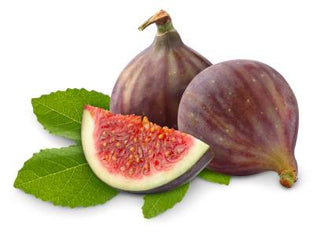(Ficus carica)
Figs, which grow on the Ficus tree, are unique in that a hole or opening is made on tree stem to allow the fig to grow. Although a fruit, a fig is considered a false fruit or multiple fruit because the flowers and seeds grow together to form a single mass. The fig is actually a flower inverted into itself. The seeds inside the fig are the actual drupe or stone fruit of the plant. Figs are also unique in that they are the only fruit to ripen on the tree.
Figs are succulent and sweet with a chewy texture, crunchy seeds and a smooth skin. Today, over 600 varieties of figs covering a dramatic range of colors and textures are grown. Figs can be green, yellow, purple, and black, just to name a few.
Figs are native to the area between Turkey and India. Thousands of years ago, their popularity spread in the Mediterranean region. Figs are mentioned throughout ancient literature – most notably as the favored fruit of the Bible. Fig cultivation is thought to have begun in Egypt and spread in popularity to the Greeks and Romans. By around the 9th century B.C., figs had become a staple in the Grecian diet (a tradition that continues today). Figs were so prized in ancient Greece that it was illegal to export them; Greek leaders did not want their national treasure made available to others!
Figs made their debut in the U.S. by the hands of Spanish missionaries sometime during the mid 18th century. Fig production in Southern California caught on quickly and today California produces millions of pounds of figs each year. Figs made their first commercial product appearance in 1892 with the introduction of Fig Newtons.
Today, the primary producers of figs (fresh and dried) include United States, Turkey, Greece, Portugal and Spain. A few of the most popular varieties of this fruit are Black Mission (blackish-purple skin and pink flesh), Kadota (green skin and purplish flesh), Calimyrna (greenish-yellow skin and amber flesh), Brown Turkey (purple skin and red flesh) and Adriatic (light green skin and pink-tan flesh).
Nutrition Facts
From a nutritional standpoint, fresh figs are better than dried. However, even raw figs are very sweet as one large fig contains 47 calories and 10 grams of sugar. On a positive health note, one fig provides about 2 grams of fiber. Although a 1/2 cup of dried figs contains 7 grams of fiber, this serving packs almost 200 calories and 36 grams of sugar!
While not loaded with vitamins or minerals as some fruits, a fig contains a small amount of vitamin K, vitamin B6 and manganese. One fig also provides about 149 mg of potassium or 4% of daily values.
Due to their extremely short shelf life, the majority of fresh figs are dried. Dried figs are often treated with sulfur dioxide gas during processing which can cause adverse reactions for those who are asthmatic. To preserve their color, figs (like dried apricots) are often treated with sulfites. Those allergic to sulfur-containing preservatives need to avoid this fruit or purchase organically grown figs.
Selection & Storage
California fresh figs are available June through September. Dried figs can be found in most grocery stores year round.
Fresh figs have fragile skins and bruise extremely easily. Because figs are one of the most perishable fruits, it is best to purchase no more than a day or two before you intend to enjoy. When making your selection, look for plump figs with a rich, deep color. Figs should feel tender, but not mushy. Smell can also be an indication of freshness. Figs should smell mildly sweet – a sour smell may suggest the figs are spoiled.
When you bring your figs home, store in the refrigerator on a plate or in a shallow dish lined with a paper towel. Figs should be covered, this will insure they remain fresh and do not absorb odors from other foods. Slightly unripe figs can be kept on a plate at room temperature. They should ripen within a day.
I you choose to purchase dried figs, make sure they are relatively soft, free of mold and have a mellow sweet smell.
Recipes
If fresh figs are not available, dried can be substituted for still delicious results.
Although high in sugar, pureed dried figs are an excellent replacement for fat in your baked goods. Fig puree can be used in place of butter or oil, although for the best results substitute the fig puree for only half of the fat keeping the remaining amount in its original form.
If you love figs and are looking for a special treat, purchase Dalmatia's Orange Fig Spread. You can purchase from stores like Whole Foods and some gourmet shops. Serve with a little goat cheese on crackers. It is terrific!
For a delicious bread, try Fresh Fig Focaccia. For dinner, try Fig and Chile-Glazed Pork Tenderloin. The spicy glaze is also fantastic served over chicken thighs. For a dinner where the sauce is center stage, try Chicken with Balsamic-Fig Sauce. Make a little extra sauce to pour over wilted spinach for a side dish sure to impress all of your guests.
Fun Facts
Figs contain a natural humectant - a chemical that will extend freshness and moistness in baked products.

